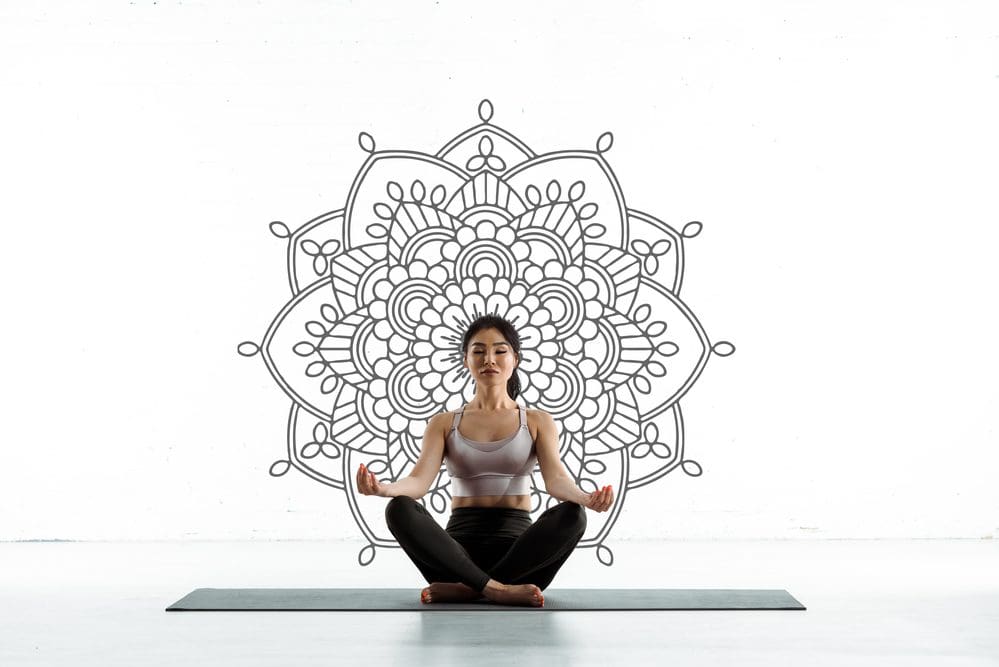Full Disclosure: Clicking on these links could mean a tiny commission for me, at no extra cost to you.
Mandalas are more than just beautiful geometric designs, with benefits that go far beyond what meets the eye. This ancient art form can provide a fun and creative way to reduce anxiety, manage stress and improve your overall mental health. It may be hard to believe, since a mandala looks like nothing more than a stunning piece of art, but don’t be mistaken. Once you uncover the benefits of mandalas and how to use them for anxiety relief, you’ll know exactly why the colorful world of mandalas can help you find peace and balance.
What is a Mandala?
A mandala is a geometric design, typically in a circular form, that holds significant symbolic meaning in various spiritual traditions. The term “mandala” comes from the Sanskrit word for “circle,” and these mandala designs are often used as tools for meditation and contemplation.
Mandalas feature intricate patterns and symmetrical shapes, each representing different aspects of the universe and the interconnectedness of life. Commonly found in Hinduism and Buddhism, mandalas serve not only as spiritual symbols but also as artistic expressions that promote relaxation and mindfulness.
When using mandalas, people often experience a sense of inner peace and balance. This is why mandala art is a popular tools in both traditional and modern mental health practices.
Mandala Symbolism
Mandalas are rich in symbolism, with each shape, color, and pattern representing different aspects of life and the cosmos. Circles are the most common shape, symbolizing unity, eternity, and the interconnectedness of all things. Other shapes, such as squares and triangles, often represent elements like stability and transformation.
Types of Mandalas
There are several types of mandalas, each with its unique purpose and design:
- Teaching Mandalas: Used as educational tools to illustrate spiritual concepts.
- Healing Mandalas: Created for meditation and focused on bringing balance and harmony.
- Sand Mandalas: Intricate designs made with colored sand, often used in Tibetan Buddhist rituals.
How Mandalas Affect the Brain
Using mandalas can have a positive impact on the brain. The repetitive patterns and symmetry can help induce a meditative state, promoting relaxation and reducing stress. Focusing on the intricate details can also improve concentration and mindfulness.
Benefits of Mandalas for Mental Health
Several studies have highlighted the therapeutic effects of mandalas. Research has shown that mandala coloring can significantly reduce anxiety symptoms, and improve mood. In one study, participants who colored mandalas reported feeling less anxious and more relaxed compared to those who engaged in free-form coloring.
As such, there’s no denying that using mandalas can offer numerous mental health benefits, including:
- Anxiety relief
- Stress seduction
- Improve concentration and cognitive function.
- Non-verbal way to express emotions and process feelings
- Promote mindfulness and healing
- Increase focus
- Reduce negative feelings
- Release emotion, fear, worry, tension, anxiety and stress
- Increase your understanding of your anxiety disorder
- Stimulate creativity
- Release emotional blockages
- Learn how to decrease impulsive behaviour
- Promote self-discovery
- Control worrying
How to Use a Mandala as Art Therapy
Using mandalas as a form of art therapy can be a powerful way to promote mental health and emotional healing. The process involves creating or coloring mandalas, allowing you to focus their attention and express their emotions through art.
Start by selecting a mandala design that resonates with you; this could be a pre-drawn mandala colouring pages or a blank circle to fill with your own patterns. Gather your preferred art supplies and find a quiet, comfortable space. As you work on your mandala, pay attention to your thoughts and feelings, letting the repetitive, rhythmic nature of the activity guide you into a state of relaxation and mindfulness. This meditative practice can help reduce stress, increase self-awareness, and provide a creative outlet for processing emotions.
After completing a mandala, spend time reflecting on the colors, patterns, and symbols you used. Write down any thoughts or insights that come to mind, helping to deepen your self-awareness.
Here are some addition ways to use mandala art.
1. Create Your Own Mandala
Creating your own mandala can be a deeply personal and therapeutic experience. Start with a blank piece of paper and draw a large circle. From there, let your creativity flow, adding shapes, lines, and patterns that feel right to you. You can also focus on specific themes or intentions while creating your mandala, such as gratitude, healing, or love. This can provide a structured approach to exploring specific areas of your life.
Remember, there’s no right or wrong way to create a mandala.
Here are the steps on how to draw a mandala:
- Draw a dot in the center of your paper
- Grab a ruler and place it in the center of your dot
- Draw 3 dots to the left, right, top and bottom of your main dot, making sure each dot is the same distance from the center as the other
- For example: Make all of the first dots from the center a 1/2″, all second dots from the center 1″, all third dots from the center 1.5″
- Draw a vertical and horizontal line to connect the dots
- Draw another set of dots in between the lines, at the same distances from the center as the other dots you drew
- Connect the dots in circles
- For example: Connect all the first dots from the center to form a small circle, all the second dots from the center to draw a slightly larger circle and so on and so forth
- Let your mind do the rest! Fill your mandala in as you please
You can also grab a mandala kit, which comes with all kinds of tools to make stunning mandala designs.
Buy Now: Available on Amazon
2. Coloring Mandala Pages
Coloring mandalas pages is a popular and accessible way to use them for anxiety relief. There are many mandala coloring books available, or you can find printable designs online. Choose colors that speak to you and let yourself get lost in the process of coloring.
Here are some awesome mandala colouring books to get you started:
- The Mandala Coloring Book: Inspire Creativity, Reduce Stress, and Bring Balance
- Mandala Coloring Book: 100+ Unique Mandala Designs and Stress Relieving Patterns for Adult Relaxation, Meditation, and Happiness
- A Mindful Colouring Book for Men, Women, Teenagers & Seniors with Relaxing Mandala Patterns & Stress Relieving Designs
Buy Now: Available on Amazon
3. Mandala Meditation
Mandalas can also be used as a focal point for meditation. Find a quiet space, sit comfortably, and place a mandala in front of you. Gaze at the mandala, allowing your mind to relax and your breathing to slow. Let the patterns and colors draw you into a meditative state.
4. Mandala Journaling
Combine mandala art with journaling by drawing a mandala in your journal and writing about your thoughts and feelings around it. This can help you process emotions and gain insights.
5. Guided Mandala Sessions
Participate in guided sessions with an art therapist who can help you explore deeper meanings and emotions through the creation and analysis of mandalas.
6. Digital Mandalas
Use digital tools and apps to create mandalas on a tablet or computer. This can be a convenient way to engage with mandala art therapy, especially for those who prefer digital mediums.
7. Nature Mandalas
Create mandalas using natural materials like leaves, stones, and flowers. This practice connects you with nature and can be a grounding, meditative experience.
Adding Mandalas into Your Self-Care Routine for Anxiety Relief
Adding mandalas into your daily routine can be a transformative way to manage anxiety and enhance your overall well-being. By regularly engaging with mandala art, whether through mandala coloring, drawing, or meditative practices, you can create a consistent and soothing ritual that helps center your mind and reduce stress. This practice encourages mindfulness, promotes relaxation, and offers a creative outlet for expressing and processing emotions.
Plus, incorporating these beautiful art into your routine not only provides a break from daily stressors but also helps establish a calming habit that can significantly improve your mental health over time.
Daily Mandala Practices
Incorporate mandalas into your daily routine for ongoing mental health benefits. Spend a few minutes each morning or evening creating or coloring a mandala page. This practice can help set a positive tone for the day or provide a calming end to a busy day.
Using a Mandala When You’re Stressed Out
Use mandalas as a tool for managing stress. When you feel overwhelmed, take a break to work on your design. The act of focusing on the patterns and colors can help shift your attention away from stressors and promote relaxation.
Using Mandalas in Therapy
Mandalas are increasingly being used in therapeutic settings. Art therapists incorporate art creation into their practice as a way for clients to express themselves and explore their emotions. If you’re seeing a therapist, consider discussing how mandalas can be integrated into your sessions.
Conclusion
Mandalas are a wonderful tool for enhancing mental health and relieving anxiety. Whether you’re using mandala coloring pages, creating a mandala from scratch, or meditating with mandalas, the benefits are evident. Start your mandala journey today and enjoy the vibrant, calming world they offer.
Frequently Asked Questions
- What is a mandala?
A mandala is a geometric design, usually circular, that holds symbolic meaning in various spiritual traditions. It is often used for meditation and as a tool for personal growth. - How can mandalas help with anxiety?
Mandalas can help reduce anxiety by promoting relaxation and mindfulness. The act of creating or coloring a mandala can be soothing and provide a sense of calm. - Do I need to be an artist to create mandalas?
No, you don’t need to be an artist to create mandalas. Anyone can enjoy the process, regardless of skill level. The focus is on the experience and the benefits it brings. - Can children benefit from mandalas?
Yes, children can benefit from mandalas. Coloring or creating mandalas can help kids develop focus, improve fine motor skills, and provide a calming activity. - How long should I spend on mandala activities?
The amount of time you spend on mandala activities is up to you. Even a few minutes a day can be beneficial. The key is to make it a regular part of your routine. - Where can I find mandala resources?
You can find mandala resources online, in bookstores, and at art supply stores. Look for coloring books, templates, and tutorials to get started.
What is Mandala Blooms?
 We can’t complete this post without talking about how we got started with using mandalas as a form of meditation and therapy for anxiety.
We can’t complete this post without talking about how we got started with using mandalas as a form of meditation and therapy for anxiety.
Mandala Blooms is owned by Carolyn Trotter, an artist and meditation advocate living in Vancouver. She began her journey when she was going through some tough times and decided to pick up a paint brush and splatter her feelings onto canvas. She found herself focusing on the centers and couldn’t really figure out why, but painting after painting, they all had this intricate center. It was only when her friend said that they looked like mandalas that Carolyn had a “light bulb” moment. She researched the meaning of mandalas and low and behold, that’s exactly what she had been painting all this time.
Today, she sells her beautiful mandala art to help others overcome their struggles.









